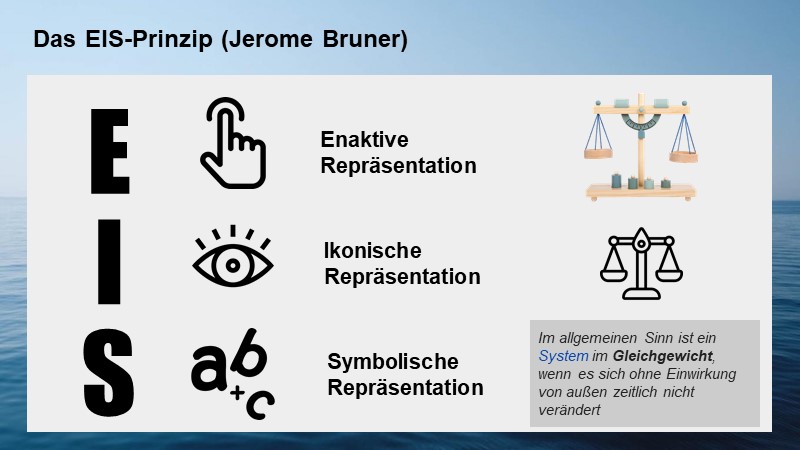Repräsentationstrias / EIS-Prinzip |

|
 BiblioMap
BiblioMap 
 Synonyme
Synonyme
Repräsentationstrias, EIS-Prinzip, EIS principle
 Definitionen
Definitionen
 Jerome Bruner classified three modes of human representation and communication: enactive (action-based, using gestures), iconic (image-based using pictures and diagrams) and symbolic (including language and mathematical symbols).
Jerome Bruner classified three modes of human representation and communication: enactive (action-based, using gestures), iconic (image-based using pictures and diagrams) and symbolic (including language and mathematical symbols). Any domain of knowledge (or any problem within that domain of knowledge) can be represented in three ways: by a set of actions appropriate for achieving a certain result (enactive representation) ; by a set of summary images or graphics that stand for a concept without defining it fully (iconic representation); and by a set of symbolic or logical propositions drawn from a symbolic system that is governed by rules or laws for forming and transforming propositions (symbolic representation).
Any domain of knowledge (or any problem within that domain of knowledge) can be represented in three ways: by a set of actions appropriate for achieving a certain result (enactive representation) ; by a set of summary images or graphics that stand for a concept without defining it fully (iconic representation); and by a set of symbolic or logical propositions drawn from a symbolic system that is governed by rules or laws for forming and transforming propositions (symbolic representation). Verwandte Objeke
Verwandte Objeke
 Verwandte Begriffe (co-word occurance) |  symbolische Repräsentation symbolische Repräsentation symbolic representation(0.65), symbolic representation(0.65),  ikonische Repräsentation ikonische Repräsentation iconic representation(0.6), iconic representation(0.6),  enaktive Repräsentation(0.58), enaktive Repräsentation(0.58),  Criterion of Sense Criterion of Sense Criterion of Sense(0.08), Criterion of Sense(0.08),  Criterion of Time Criterion of Time Criterion of Time(0.07), Criterion of Time(0.07),  Horizontal Criterion Horizontal Criterion Horizontal Criterion(0.07), Horizontal Criterion(0.07),  Vertical Criterion Vertical Criterion Vertical Criterion(0.06), Vertical Criterion(0.06),  Repräsentationskriterium(0.05), Fundamentale Ideen(0.04), echt enaktiv(0.04), Fundamentale Ideen der Informatik(0.04), spiral curriculumspiral curriculum(0.04), virtuell-enaktiv(0.03), Fundamentale Ideen der Schulinformatik(0.03) Repräsentationskriterium(0.05), Fundamentale Ideen(0.04), echt enaktiv(0.04), Fundamentale Ideen der Informatik(0.04), spiral curriculumspiral curriculum(0.04), virtuell-enaktiv(0.03), Fundamentale Ideen der Schulinformatik(0.03) |










 Werner
Werner Hendrik
Hendrik Andreas
Andreas Hans
Hans Michael
Michael




 36
36 




 Biblionetz-History
Biblionetz-History